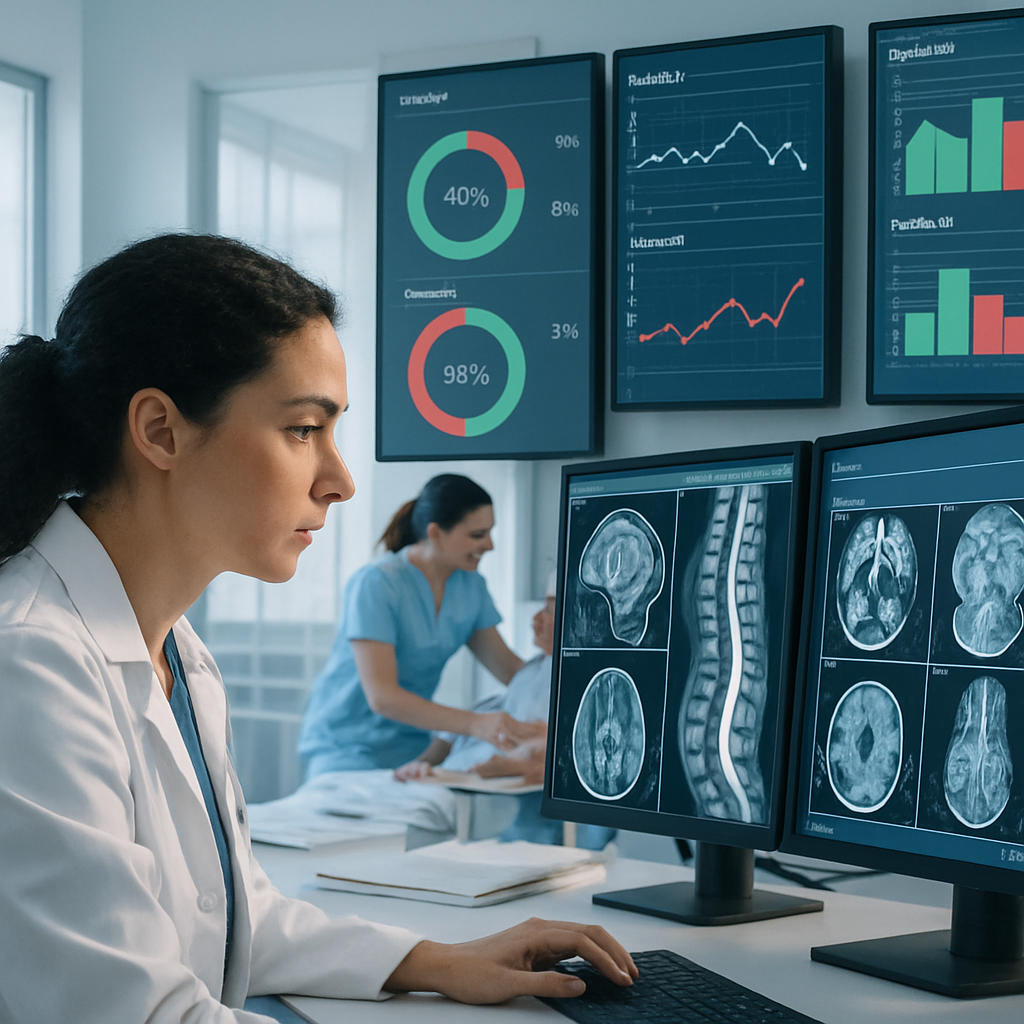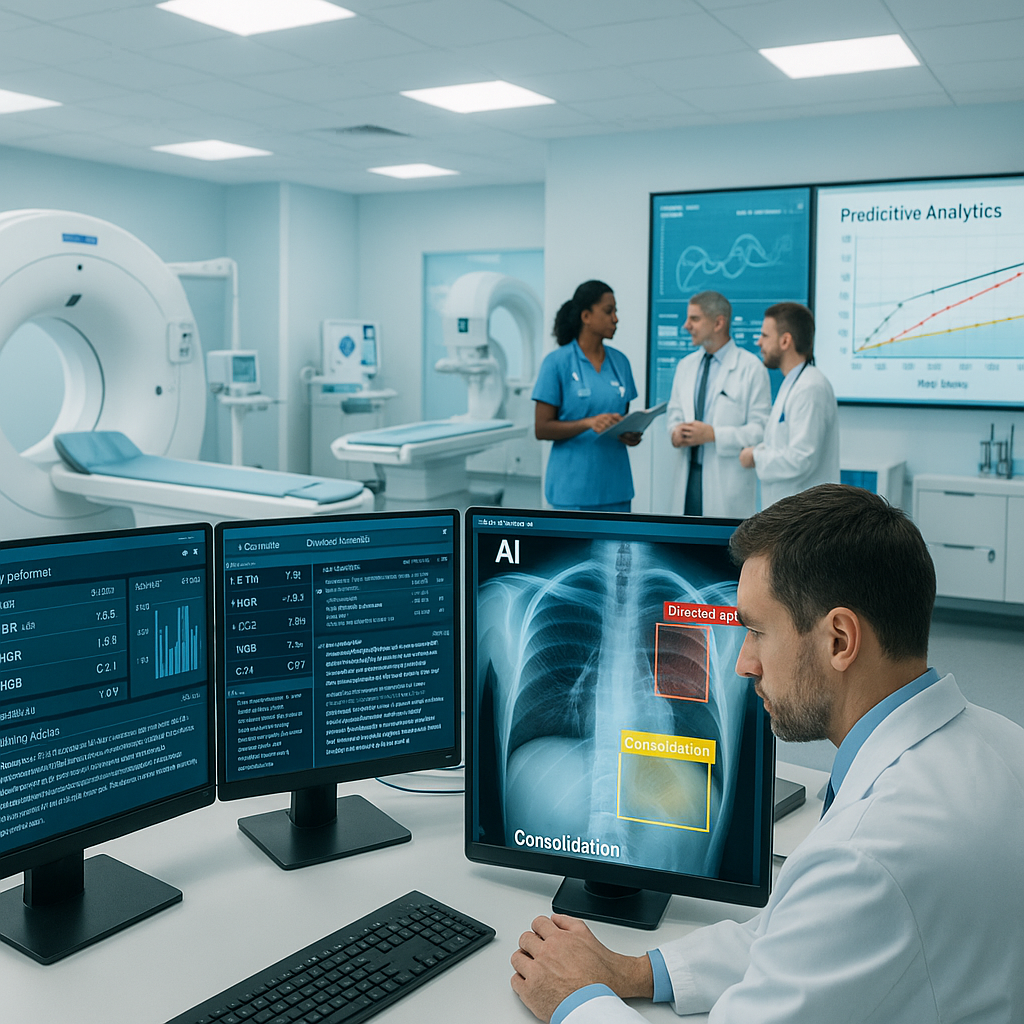Data Liquidity vs. Interoperability: Transforming Radiology Workflows with AI-Driven Innovation
In 2024, 44 percent of male radiologists and 65 percent of female radiologists experience burnout. The culprit isn’t just long hours but it’s a technological paradox that would be unthinkable in any other industry. While the global medical imaging market reached $41.6 billion in 2024 and projects 4.95% annual growth through 2030, radiologists still toggle between five separate applications to review a single case: PACS for images, RIS for scheduling, EHR for patient history, dictation software, and a separate system for prior studies.
The human cost is staggering. Radiologists report having one of the heaviest workloads among all medical specialties, and this workload has been growing steadily in recent years. Meanwhile, 692 AI-enabled medical devices have received FDA authorization as of July 2023, with over 75 percent designed for radiology applications, promising to save over 60 minutes per shift and reduce burnout. Yet most departments remain trapped in fragmented systems that delay diagnoses, increase costs, and fuel the burnout epidemic.
The problem is architectural. Healthcare has invested billions achieving basic interoperability, but we’ve fallen short of true data liquidity. This distinction isn’t academic; it’s the difference between having connected systems and truly intelligent, responsive healthcare that can harness the full potential of AI innovation.
Understanding the Fundamentals
Interoperability: The Foundation
Interoperability represents the basic ability of health IT systems to exchange and display information. This means DICOM images moving from modalities to PACS, HL7 feeds sending patient demographics between systems, and DICOMweb enabling secure, cloud-based sharing.
FHIR is a set of rules and specifications for the secure exchange of electronic health care data designed to be flexible and adaptable across different healthcare information systems. The healthcare interoperability market reflects this importance, with market size expected to reach US$ 14.7 billion by 2034 from US$3.9 billion in 2024 at 13.89 percent annual growth rate signaling massive industry investment.
Beyond Basic Exchange
Data liquidity ensures that discrete, structured data elements are captured once and effortlessly reused across analytics platforms, AI workflows, and decision-support systems, completely eliminating the need for manual re-entry. FHIR promises to address many of the core data liquidity barriers to success by standardizing granular health data exchange.
Consider the difference: In traditional interoperable systems, radiology reports are sent as PDFs to EHRs where they can be viewed but not analyzed. In data-liquid systems, reports contain structured, coded findings (measurements, standardized terminology, quantitative metrics) immediately available for AI analysis, population health monitoring, and clinical decision support.
All data liquidity requires interoperability, but not all interoperability achieves data liquidity. Interoperability focuses on system-to-system exchange through document-centric formats like PDFs, limiting downstream use to viewing stored documents with manual extraction required for AI enablement. Data liquidity emphasizes reusable, analyzable data elements in structured fields with coded findings, enabling native analytics, AI workflows, and real-time decision support where structured data feeds algorithms directly.
The Radiology Workflow Crisis
Radiology departments are facing unprecedented challenges. Managing three to five applications for a single case adds cognitive strain and increases the risk of errors. When systems fail to communicate effectively, the result can be delayed access to critical priors leading to missed diagnoses, unnecessary repeat exams that increase costs and radiation exposure, and administrative burdens that take radiologists away from patient care.
But the transformation potential is significant. AI systems can reduce interpretation delivery times from 11.2 days to a mere 2.7 days, reinforcing the potency of automated triaging systems. Realizing this potential requires an underlying data infrastructure that makes AI truly effective.
The Game Changer
True data liquidity transforms radiology from reactive to predictive. Structured imaging data becomes fuel for sophisticated analytics enabling:
- Predictive Triage: AI analyzes structured metadata, acquisition parameters, patient history, and clinical indicators to automatically prioritize cases based on the likelihood of critical findings, ensuring that stroke alerts and suspected malignancies receive immediate attention.
- Quality Assurance: Real-time tracking of repeat examination rates, patient dose monitoring, and diagnostic accuracy feeds dashboards helping leaders identify improvements and demonstrate value.
- Research Acceleration: AI-generated insights are incorporated directly into structured reports, making it easy to identify patient cohorts for clinical trials. Instead of manually reviewing thousands of reports, researchers can run standardized queries and move faster from hypothesis to enrollment.
- Protocol Optimization: Data-liquid systems recommend scan protocols tailored to each patient, balancing image quality with safety. This ensures diagnostic precision while minimizing radiation exposure and streamlining workflows.
This creates a virtuous cycle: better structured data enables sophisticated AI, which generates valuable insights, improving patient care and efficiency exponentially.
The Foundation: Interoperability Standards
FHIR specifies a core set of resources as the fundamental units of interoperability with each representing a specific type of information in healthcare, such as a patient, an observation, medication, diagnostic reports, and more.
Key radiology standards include DICOM for imaging data, DICOMweb for cloud-native sharing, HL7 v2.x and FHIR for clinical data exchange, and IHE implementation guides ensuring real-world effectiveness. FHIR’s internet-based approach to sharing and exchanging information allows data to move across various platforms while standardizing data exchange methods to lower expenses associated with data sharing.
Without interoperability, organizations face proprietary data formats, manual re-entry across systems, increased error risk, higher integration costs, and limited AI leverage ability. Interoperability alone creates data dumps, information that can be received but not effectively used, creating false progress.
Care.IO’s Approach: Bridging Both Worlds
- Care.IO represents a new platform generation recognizing the essential interoperability-data liquidity relationship. The cloud-native architecture eliminates traditional sharing barriers while ensuring every captured data element becomes immediately available for downstream analytics.
- Standards-Based Integration: Comprehensive DICOM and FHIR support ensures seamless PACS, RIS, and EHR integration without infrastructure overhauls.
- Structured Data Capture: Beyond basic sharing, the platform captures and standardizes metadata (ICD-10 codes, standardized lexicon terms, quantitative measurements) ensuring data enters in formats enabling immediate AI processing.
- AI-Powered Workflow: AI automation saves radiologists 60 minutes per shift through intelligent case triage, automated quality monitoring, and protocol optimization occurring in real-time.
- Security and Compliance: AES-256 encryption, zero-trust architecture, role-based access controls, and full HIPAA/SOC II compliance ensure comprehensive protection.
The Future: Transformation Potential
The interoperability-data liquidity convergence enables fundamental healthcare delivery transformation. Instead of simply responding to orders, radiology departments can proactively identify screening candidates, monitor population trends, and contribute to preventive strategies.
European radiologists expect the AI impact predominantly on breast and oncologic imaging, primarily involving CT, mammography, and MRI. Advanced AI will provide real-time clinical decision support, automated quality assurance, and predictive analytics, while cross-specialty collaboration creates truly integrated care models.
Organizations with superior data liquidity gain competitive advantages through faster technology implementation, superior outcome demonstration, and increased attractiveness to modern healthcare professionals expecting advanced tools.
The Choice Before Healthcare Leaders
Healthcare stands at a critical inflection point. Traditional approaches focused on basic interoperability have reached practical limits. The next transformation phase requires fundamental shifts toward true data liquidity.
For radiology departments, this transformation isn’t optional. Increasing imaging volumes, physician shortages, rising quality expectations, and value-based care contracts demand sophisticated data management approaches.
Interoperability provides essential technical infrastructure enabling system communication. Data liquidity provides transformative capability by turning raw data into actionable intelligence improving patient care, operational efficiency, and outcomes.
Healthcare leaders should consider: Does your system enable true data liquidity or simply move documents? Can radiologists access needed AI-powered tools? Can you demonstrate measurable quality, efficiency, and satisfaction improvements? Is your infrastructure positioned for future AI and analytics innovations?
Care.IO helps you answer yes to every one of these. Our platform delivers seamless data liquidity, empowers radiologists with integrated AI tools, tracks and demonstrates measurable improvements, and future-proofs your infrastructure for ongoing innovation.
With Care.IO, you don’t just keep up, YOU LEAD!



